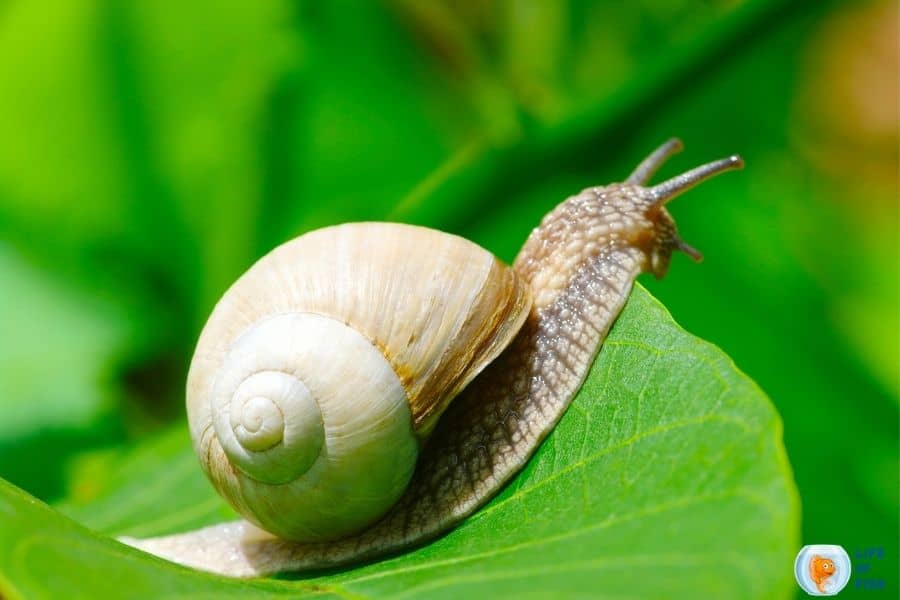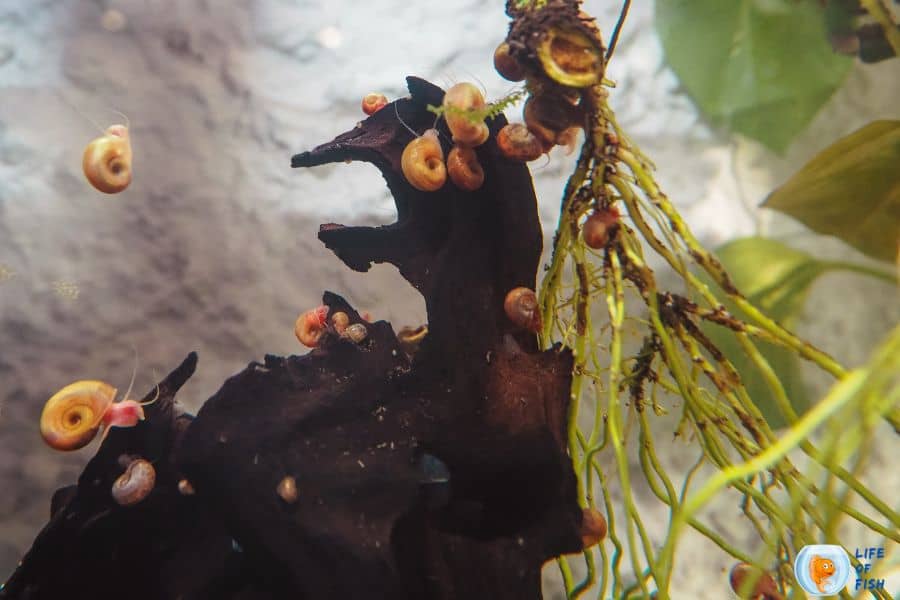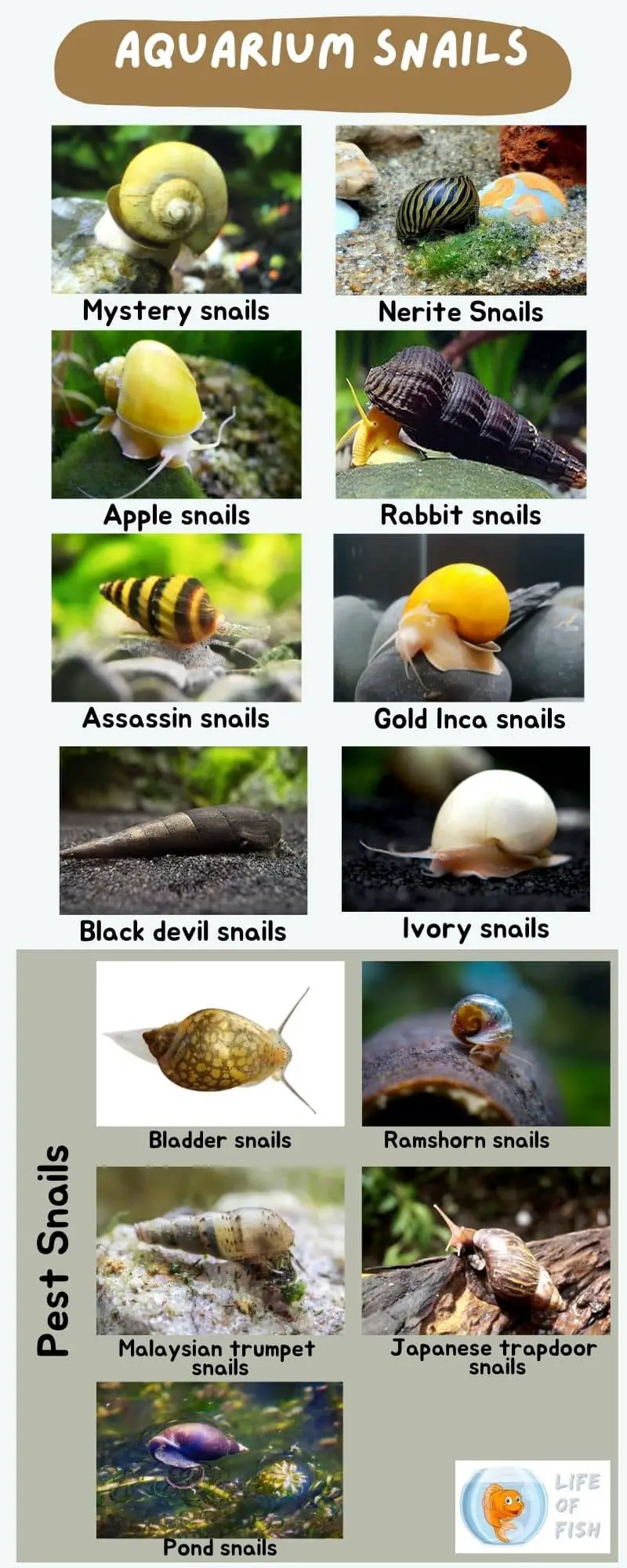Having a variety in an aquarium makes it more interesting. That’s why most aquarists tend to keep community tanks rather than species-only tanks.
While snails are not the most popular creatures in the tank, they can actually do a lot to improve water quality.
Not to mention, they are very interesting to watch! There are many different types of aquarium snails available on the market. We have gathered 13 types of aquarium snails in this article.

Are snails beneficial in an aquarium?
Jump To
Yes. The main source of food for most aquarium snails is algae and detritus. This means that they can help keep your aquarium clean.
In addition, they eat uneaten fish food, which can help reduce waste in the tank. Hence they help to keep the water quality high.
Aquarium snails are also known to aerate the substrate, which can help to promote plant growth. In addition, some species of snail, such as the Nerite Snail, are known to eat hair algae, which is a type of algae that is difficult to get rid of.
So, as you see, snails are, in fact, beneficial in an aquarium if they are present in the right numbers.
Can aquarium snails become pests?
When aquarium snail populations explode, they can become pests. This is especially true for smaller aquariums.
They can quickly take over the tank and become a nuisance. They can also disturb the roots of plants and uproot them.
Further, baby snails can get into filter intake tubes and clog them, making it difficult for water to flow through the filter.
In addition, some species of snail, such as the Apple Snail, are known to eat live plants. This can be a problem for planted tanks.
On the whole, as long as you keep the population of aquarium snails under control, they should not become a nuisance. If your aquarium has too many snails, it is best to eliminate some of them.
Good snails vs. bad snails
People tend to categorize snails as good or bad based on their effect on the aquarium. However, this is not really fair because it depends on the individual snail and the aquarium environment.
For example, a snail considered a pest can actually be beneficial in a different aquarium(Ex: Ramshorn snail). It all depends on the situation.
Some aquarists consider snails such as the Mystery Snail, Nerite Snail, and Ivory Snail to be good snails because they are known to help keep the aquarium clean and do not reproduce rapidly.
On the other hand, species such as the Malaysian Trumpet Snail and Ramshorn Snail are considered bad because they can quickly become trouble in an aquarium.
However, if you keep nerite snails in a saltwater aquarium, they will become a pest as the conditions for nerite snails to reproduce are present in brackish water. So, it all depends on the snail and the aquarium environment.

Types of aquarium snails
There are many different types of aquarium snails available on the market. Here are 13 of the most popular:
Mystery snails
Mystery snails are among the most popular aquarium snails. They are known for their large size and their beautiful colors.
Mystery snails come in various colors, such as gold, blue, maroon, white, and ivory.
Mystery snails are very easy to care for, and they are known to be good algae eaters. In addition, mystery snails are also known to eat uneaten fish food.
Due to their large size (1.5 inches), they fit most aquarium sizes as it is relatively hard for predator fish to eat them. However, they can become a pest in smaller aquariums as they can quickly overpopulate the tank.
Unlike many other snail species, these snails lay eggs above the water surface, and the eggs hatch in about two weeks.
The baby snails will then drop into the water and start to grow. So, if you don’t want to raise more mystery snails, it is easy to get rid of them before the eggs hatch.
Nerite Snails
Nerite snails are another popular type of aquarium snail. They are known for their beautiful shell patterns and their hardiness. Nerite snails come in various colors and patterns, such as zebra, tiger, olive, and black.
Nerite snails require little care and can thrive in both freshwater and brackish water. They live for around five years and do not reproduce in freshwater. This makes them ideal for community tanks as they will not overpopulate the aquarium.
Nerite snails are very good algae eaters, and they will help keep your aquarium clean. In addition, nerite snails are known to eat uneaten fish food. Another benefit of Nerite snails is that they do not eat plants.
Due to their small size (0.5 inches), nerite snails can be kept in both small and large aquariums.
However, nerite snails are known to escape from aquariums. So, it is important to have a lid on your aquarium if you decide to keep nerite snails.
Apple snails
Apple snails are one of the largest types of aquarium snails. They can grow up to 5 inches in length, and their shell can be up to 3 inches wide. Apple snails come in a variety of colors, such as blue, gold, pink, and ivory.
Apple snails are voracious plant eaters, and they will eat almost any type of plant in your aquarium.
So, if you are a heavy aquascaper, Apple snail is not the snail for you. Apple snails are also known to eat uneaten fish food, algae, and detritus. This makes them great tank cleaners for any size of a fish tank.
Apple snails are very easy to care for, and they have a lifespan of about three years. Apple snails can live in both freshwater and brackish water (if acclimated properly). However, if you keep apple snails in a saltwater aquarium, they will not survive.
Rabbit snails
Rabbit snails are a type of aquarium snail that is becoming increasingly popular. They get their name from their rabbit-like face, large size, and long, spiral shell.
Rabbit snails can grow up to 5 inches in length, and their shell can be up to 3 inches wide. They come in various colors, such as brown, black and white.
Rabbit snails are not an easy-to-care-for creature as it has specific water condition requirements as they come from Sulawesi, Indonesia. They also require a high humidity level and a sandy substrate to burrow.
Rabbit snails are excellent algae eaters, and they will help keep your aquarium clean. Due to their slow-moving nature, they are known to clean any surface thoroughly, which makes them ideal for larger aquariums.
Assassin snails
Assassin snails are a type of aquarium snail that is known for their ability to control other snail populations.
They are voracious eaters, and they will consume any type of snail that they can fit in their mouth.
This includes other assassin snails. So, if you are planning on keeping assassin snails, make sure to get only a few of them.
Assassin snails are popular among hobbyists for another reason, their beauty. Assassin snails have a conical shell that is brown or black in color. The shell has a glossy finish, and it is adorned with yellow, brown, or brown stripes.
As hardy creatures, these snails don’t require much attention. Assassin snails can thrive in freshwater as well as slightly brackish water (around SG 1.003).
Gold Inca snails
Gold Inca snails, also known as golden Inca snails, are a beautiful type of aquarium snail. They get their name from their Inca-like shell design and their gold color. Gold Inca snails are one of the larger types of aquarium snail, growing up to 2 inches in length.
As a relatively new addition to the aquarium snail world, not much is known about them.
However, they are believed to be peaceful snails that will not bother other tank mates. Gold Inca snails are also believed to be good algae eaters.
Gold Inca snails can accommodate both large and small tanks as it is a medium-sized aquarium snails. However, they require a soft sandy substrate to burrow and hide in.
Black devil snails
They are type of aquarium snail that is native to the Indo-West Pacific region. Black devil snails get their name from their black color and their devil-like facial features.
They can grow up to 3.5 inches in length, and their shell can be up to 2 inches wide. They have a life span of up to 6 years in captivity.
Black devil snails are painless creatures as they can live in both freshwater and brackish water. They are also known to be good algae eaters.
However, black devil snails are not yet popular in the aquarium trade, and they are difficult to find.
What’s good about these snails is that they do not breed in freshwater. They require a salinity of at least 1.018 to lay their eggs. You don’t have to be concerned about their overrunning your tank.
Ivory snails
Ivory snails, also known as spike-topped apple snails, are a type of aquarium snail that is native to South America.
They get their name from their ivory-colored shell and their spike-like protrusions on the top of their shell.
Ivory snails can grow up to 2 inches in length, and their shell can be up to 1.5 inches wide. They have a life span of up to 1 year in captivity.
Ivory snails are peaceful creatures that will not bother other tank mates. They are also good scavengers, making them good tank cleaners. However, Ivory snails are known to eat plants, and they will uproot them in search of food.
As a result, Ivory snails are not recommended for planted tanks. Ivory snails require at least about a 10-gallon tank, and the tank should be well covered as they are known as escape artists.

Pest snails
Just like pet snails mentioned above, there are pest snails as well. Pest snails are usually introduced to the aquarium accidentally through live food or plants. Once they are in the tank, they can quickly multiply and become a nuisance.
Pest snails are often smaller than pet snails and have a duller shell coloration. They are also known to eat plants, and they can uproot them in search of food. Pest snails are not recommended for planted tanks.
Pest snails can be difficult to get rid of as they can quickly multiply. The best way to prevent them from taking over your tank is to regularly check your live food and plants for snail eggs before adding them to the tank.
It is also vital to quarantine new fish and plants before adding them to your tank.
Bladder snails
The bladder snail is one of the ugly-looking types of aquarium snail. They get their name from the inflated, sac-like structure on their underside, which is used to store air.
Bladder snails can grow up to 0.5 inches in length, and their shell is usually a drab brown color. They have a life span of up to 2 years in captivity.
Bladder snails are not considered to be good tank mates as they are known to eat plants and reproduce very quickly. They are also hard to get rid of once they are in the tank.
As a result, bladder snails are not recommended for aquariums.
Ramshorn snails
Ramshorn snails, also known as red ramshorn snails, are, in fact, aquarium pets. They have an attractive shell that is shaped like a coil.
The shell comes in different colors: red, brown, pink, blue, and black. Ramshorn snails can grow up to 1 inch in length, and their shell can be up to 0.5 inches wide. They have a life span of up to 2 years in captivity.
Rams Horn snails are docile and non-destructive in the aquarium. They may be kept with any other fish, as they are peaceful. However, Ramshorn snails can multiply quickly, and they may become a nuisance in the aquarium.
As a result, it is vital to keep an eye on their population size and to remove any excess snails and snail eggs from the tank.
Malaysian trumpet snails
Malaysian trumpet snails are a type of freshwater snail that is native to Southeast Asia. They get their name from their long, cylindrical shell that is trumpet-shaped.
Some hobbyists regard them as pets, while others view them as pests. Malaysian trumpet snails can reach lengths of up to 1 inch and have shells up to 0.5 inches wide. They have a life span of up to 3.5 years in captivity.
What makes them pests is their reproducing ability. The females can reproduce with or without males, and they reproduce so fast.
Malaysian trumpet snails are live-bearing, so the female can give birth to up to 30 young snails at a time.
Another problem with Malaysian trumpet snails is that they are known to eat plants. As a result, they are not recommended for planted tanks.
If you do not want them in your tank, the best way to get rid of them is to remove them from the tank manually. This can be difficult as they tend to bury themselves in the substrate.
You can also use an aquarium snail trap to catch them.
Japanese trapdoor snails
Japanese trapdoor snails are pretty and low maintenance freshwater snails that can raise as pets, but they can also be pests because of their invasive nature.
They are native to East Asia, and they get their name from the trapdoor-like operculum on their shells which is used to close the shell opening.
Japanese trapdoor snails can grow up to 2 inches in length, and their shell can be up to 1 inch wide. They have a life span of up to an impressive ten years in captivity.
In the wild, Japanese trapdoor snails are known to eat algae, detritus, and dead plants. However, in the aquarium, they are known to eat live plants as well.
But, they will eat plants only if they are extremely hungry. So, if you provide them with plenty of food, your plants will be saved.
If your aquarium has an algae bloom, then these snails can help control the algae population.
Yet, these little critters are considered pests in the aquarium industry. It is because they reproduce rapidly.
Their hardy nature makes them immune to most snail diseases, making them hard to kill. So, they can quickly overrun an aquarium and become a nuisance.
The effective method to get rid of these snails is to manually remove them from the aquarium. But, this can be difficult as they are good at hiding.
Pond snails
Pond snails are among the animal kingdom’s most disgusting and ugly-looking creatures. They are slimy, have a long body, and are just plain gross. Surprisingly, some people regard them as pets.
Pond snails are freshwater snails that are common in many countries. They get their name from their natural habitat, which is, you guessed it, ponds.
Pond snails can grow up to 2 inches in length, and their shell can be up to 1.5 inches wide. They have a life span of up to 1 year in captivity.
Pond snails are hermaphroditic, meaning that each snail has male and female reproductive organs.
As a result, they can reproduce without the need for a mate. The female pond snail can lay up to 500 eggs at a time, and they can lay eggs multiple times in their lifetime.
Pond snails are considered pests in the aquarium industry because they are known to eat live plants and reproduce fast.
They even consume soft, new leaves of plants. So, if you have pond snails in your aquarium, your plants are in danger.
The effective method to get rid of pond snails is to manually remove them from the tank. You can also catch them with a snail trap.
Wrapping Up
Aquarium snails can be both good and bad. It all relies on the type of snail and the purpose you want them to serve in your aquarium.
If you want them as pets, then many good species of snails make great pets. But, if you’re going to get rid of them, then there are many methods that you can use.
Whether you want them or not, aquarium snails are here to stay. So, it is essential to know about them and their different types.
This article has provided you with the necessary information that you need to know about aquarium snails.
Read Next : What To Feed Aquarium Snails? (They Are Not Picky)
